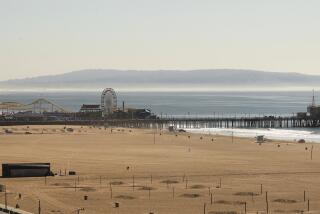Santa Monica, California Give Up on Beach Club Swap
- Share via
Santa Monica and the state have abandoned an attempt to exchange a city parcel of beachfront property for the state-owned Sand and Sea Club and will try again to agree on a use for the former estate of actress Marion Davies.
The two governmental bodies had tried to work out the exchange to break a four-year impasse over the future use of the five-acre parcel, located in the heart of Santa Monica’s Gold Coast, a strip of expensive beach homes built in the 1920s and ‘30s by motion picture moguls.
Although the state has owned it for 30 years, the Sand and Sea, at 415 Pacific Coast Highway, has been run as a private club with cabanas, swimming, paddle tennis, dining and liquor facilities for 2,200 dues-paying members, not for the public.
Santa Monica City Manager John Jalili said that a land swap, with the city acquiring rights to the Sand and Sea Club property, would have made it easier to develop a new plan for the property.
“Had we acquired control of the property,” Jalili said, “any new plan would only have required approval from the city and the state Coastal Commission, rather than requiring additional approval from various state agencies and the entire Legislature.”
He said there was not enough city land available to swap for the Sand and Sea property. The city had only a 1 1/2-acre parcel at its southernmost edge, at Santa Monica’s border with Venice. “We offered what we had, the state rejected the deal,” Jalili said.
The possibility of a land swap has been pursued since 1984 after it became apparent that the state was not going to accept a city proposal made in 1982 that Doug Badt, operator of the Sand and Sea Club, be awarded a 10-year lease.
The city chose Badt over four other competitors, including the owners of Michael’s, Perino’s and Gladstone’s 4 Fish restaurants.
Badt proposed to de-emphasize but not entirely eliminate private aspects of the club by allowing some public use of club facilities and by building three public restaurants.
But critics in the state Department of Parks and Recreation and its commission complained that his proposal did not go far enough to open up the facility to the public.
Badt, 67, has continued to operate the facility on a month-to-month lease since his original lease expired in 1981. He pays about $110,000 a year on the lease. The funds are used by the city under contract with the state for beach maintenance and capital improvements.
The state is ready to seek a new lessor who will provide what officials consider more acceptable uses on the site. Badt, in an interview, said he will bid again.
The city will conduct the bidding, as it did in 1982, and will select the winner. The winner, however, must be approved by the state Legislature, after consultation with the state Department of Parks and Recreation, its commission and the legislative analyst.
Jalili expressed optimism Tuesday that there will be less controversy over this round of bidding because city and state officials are working together on appropriate recreational and commercial activities for the site.
“One of the big disadvantages in the other round of bidding was that the activities were not spelled out,” Jalili said. “Now they are and we anticipate far less contention than before.”
Controversial Use
Use of the property has been controversial since the state acquired it in 1956 from Joseph Drown, who bought the land from the estate of Miss Davies in 1947 and founded a private club there.
Badt took over the property from Drown in 1962 and was able to muster enough support to obtain a 10-year lease in 1972, even though the state Department of Parks and Recreation objected to the operation of a private club on state-owned property.
Former Santa Monica City Manager John H. Alschuler Jr., who tried to sell the Badt proposal to the state in 1982, said Tuesday that it is not going to be easy to come to an agreement over appropriate new uses for the site.
“You have competing interests who want different things for the property,” said Alschuler, now a consultant working out of New York City. “Some people say a parking lot would be the best use for the property in terms of public access, others believe that a commercial venture returning big bucks to the state is best, while the current users of the facility probably favor leaving the club as it is. Reconciling those diverse views is not going to be like having a picnic.”
More to Read
Sign up for Essential California
The most important California stories and recommendations in your inbox every morning.
You may occasionally receive promotional content from the Los Angeles Times.










